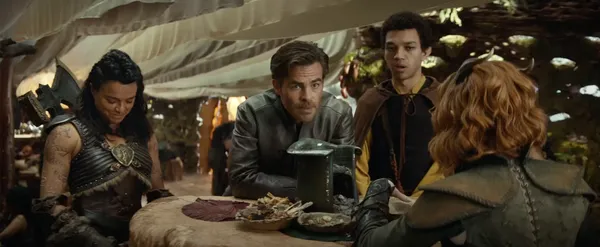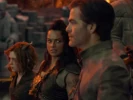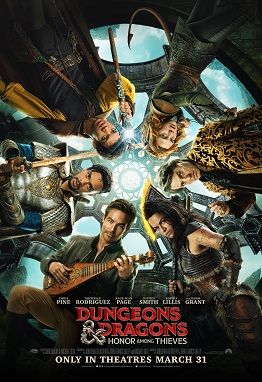Eye For Film >> Movies >> Dungeons & Dragons: Honour Among Thieves (2023) Film Review
Dungeons & Dragons: Honour Among Thieves
Reviewed by: Andrew Robertson

Dungeons And Dragons has a long history, enough that by some measures it'll be celebrating its 50th anniversary in 2024. It's a subcultural touchstone, currently on (again by some measures) its fifth (or eleventh) edition, and like many pillars of geekery its processes and quirks have become staples of related media.
I say 'pillars' in part because it lets me make a knowing nod to Dune. D&D's Basic Set came out in 1977 which puts it firmly in the same demographic bracket as Star Wars. The parallel evolutions of roleplaying and film are a whole separate entity, but suffice to say that there was a period where multimedia juggernauts of the Eighties had roleplaying games in the same way that multimedia juggernauts of the Nineties had computer games and our modern MC and DC have spinoff shows on equally acronymic streaming platforms. There are weird exceptions. The Green Knight had a boxed set that is a conscious echo of White Box D&D, and I've got a copy of the roleplaying game based on Ghost Dog: The Way Of The Samurai that I treasure. Discussion of other books is a poor guide, there's more than one compendium, folio, indeed a handful of manuals. The ur-text is not these, nor even Chainmail (Gygax, Perren et al, Guidon Games, Lake Geneva, Wisconsin, USA 1971), but The Lord Of The Rings.

There are two broad tendencies in fantastic creation, I will argue, and I will not delve into processes of production or the Campbellian hero-myth or the like. I'll muddy the waters further by suggesting that they are close mirrors to each other, not least because it involves the difference between a vision and an aesthetic. I shan't stray too far into discussions of gendered spaces in fandom between understanding and collecting, but they may serve as a (ring of) jumping-off point for the trends. The difference between Dune and Star Wars is not one was written in the Fifties and one stole heavily from it decades later, nor are their similarities in that their filmic output is mixed. The distinction is that Dune is based on an individual's creative process, Frank Herbert's, and Star Wars is based on a collective creative process. Lucas might have been a guiding light, but he initiated a reaction that started an agglomeration, a katamari of cinematic borrowings, an aesthetic reaction where things were made to fit but in a way that is recognisably Star Wars.
To borrow from Iain M Banks, it's a hegemonising swarm, but its processes of integration are about rotating the things they take to the spaces that need filled rather than growing things to fill them. Avatar might borrow but relentless filmic technician James Cameron cuts and shapes his theft until it dovetails with Carpenter-like precision. Lucas' (et al) steal but neither file the serial numbers off nor trim the edges until you can see "samurai space-Western" and recognise what I'm talking about.
In the filmed Dunes auteur (and producer meddling) attempted to reflect authorial intent. When it works, when Jackson re-tells Tolkein's stories within constraint, you get spooky greatness. That's creation to justify creation near enough - John Ronald Reuel's Middle-Earth was a playground for language invention, and Peter Robert's Middle-Earth was a playground for physical construction, Weta and more. When it doesn't quite work, when Jackson re-tells Tolkein's childhood stories for adult audiences, when Lynch (and de Laurentis) and Villeneuve tell Herbert's story when those same fields have been left un-fallow to the point that they are desert, the spice of life is buried under drifts of later material. That's different for things like Star Wars, where new shapes (Rogue One) emerge from the accretion.
Which is to say that, at root, Dungeons & Dragons is a process of creation. At countless tables across the world groups of players and their Dungeon Masters are creating worlds and characters and wonders and conflict from a set of rules. Does Star Wars have rules? You can feel its boundaries or its direction, and some of those come from process. A puppet is more likely to be Star Wars than something not a puppet. Laser swords, yes. Flamethrowers? Maybe not. A giant mechanical spider? Not quite there. A giant mechanical spider with a human-looking eye peeking out from behind a camera lens? You'd be a Mad God to disapprove.
All of this to get to a point where I will say that Dungeons & Dragons: Honour Among Thieves manages to include large numbers of the symbols and signs of its inspiration, but (albeit with a few caveats) also manages to replicate the feel of the game.
Among its strengths, the charisma of its cast. Chris Pine's Edgin is the ostensible intelligence of the party, providing bardic inspiration to the rest. Michelle Rodriguez has a type, cast despite her dexterity as an actor as a brawny fighter with a tender side. Justice Smith plays Simon (the Sorcerer, one of innumerable Easter Eggs) though he pays for his position through potential as much as backstory. Sophia Lillis' Doric extends past the 'core' conceits of Dungeons & Dragons into newer territories. A Tiefling, her nature is drawn from 1994's Planescape but they only became supported playable characters from 2007's 4th Edition. Joining them all is Regé-Jean Page as Xenk, and his character serves as what amounts to the dividing line for reactions.
Xenk is a Paladin (sub-class of Fighting-Man, from 1975's Greyhawk), and is such a paragon of virtue that his commitment to the straight and narrow sees him go over rather than through. 'Straight' being perhaps triply apposite, as while much of the film indulges in knowing winks there seems a desparate attempt to avoid anything camp. There are rooming houses, inns, taverns, even a couple of palaces, but it's slightly uncanny to see something this heteronormative. As I'm throwing the polysyllabic around I'll note that Xenk's vocubulary seems a deliberate nod to Gygax' own fondness for thesaurian depths, many a connisseur of conjuration has been unmade by D&D's authors' fondness for les mots juteux, poll-axed by pronunciation as their read exceeds their grasp.
The debt that writing partners Jonathan Goldstein and John Francis Daley (Horrible Bosses, Cloudy With A Chance Of Meatballs 2) and Michael Gilio owe to the Marvel Cinematic Universe is non-trivial. Daley and Goldstein penned Spider-Man: Homecoming and Gilio's last gig was Jessica Chastain's film debut Jolene. There's also a story credit for Robot Chicken/The Lego Batman Movie director Chris McKay, whose other writing credits include kids TV show Lunar Jim.
They've clearly hitched their wagon to the Guardians Of The Galaxy train, and while Pine and Pratt are just some of the Chrisses modern cinema requires us to distinguish as they engage with the Jack Ryan/Star Trek/Jurassic franchises at different times, it gets harder in circumstances like this.
There are homages to heist movies, to prison escapes, there are at least four dragons (or dragonkin or dragon-shaped antagonists) and innumerable dungeons. There's one journey that feels like skipping across three random hexes, each one garnering support of a different nation's national film body. That's to bring in a cynicism that the film does seem to strive to avoid, but its knowing winks at times feel like laughing at rather than with.
Its comic sensibilities are often of comic book movies. There are shots that are barely re-skinned recreations of moments from the various Avengers, all the films but also the heroes themselves. If you enjoyed Thor: Ragnarok, many of its best bits are here, but differently dressed. Hugh Grant is clearly having a lot of fun, though perhaps not as much as Hugh Bonneville in Mummies or Roger Allam in Tetris. Not that English character actors have a monopoly on villainy, especially when Hasbro are involved.
For many, awareness of D&D will be through Stranger Things, and there's a weird recursive debt owed to its Vecna, though one has to hand it to the way they've eyed up its opportunities and attacked them. There are nods to Indiana Jones though not the core conceit of tomb-raiding, to Cube, to Cabin In The Woods, to The Hunger Games, to even geekier things like the multi-part models in a treasure-cave that resemble little so much as the models from the Warhammer 40,000 2nd Edition box-set. Not the cardboard Killa-Kan, admittedly, but the Gretchin and the way the bolters are attached to the Space Marines.
That might be on me though. I made a list of D&D references and they included a particular nod to the probability of decapitation. I know there will be audiences that will allow them past without any great notice and others who will become Rick Dalton, his beer raised. Two iterations of Bigby's Grasping Hand wrestling might seem over the top, but it's a sequence that works. Not as well as an extended bout of necromancy that feels like a catacomb-constrained contribution to the Cornetto trilogy, but even then it might be of Ant-Man rather than the Winchester.
Those with weaker constitutions will consider this a test of stamina. At nearly two and a quarter hours its breezy pace sees it fly by but some of that is in comparison to even weightier works. I enjoyed it, even where it meandered. One of the cameos really reinforced the extent to which [un-named D&D 'race'] are just [elided Lord Of The Rings group] even if you didn't know they'd both been called that. Though it does underscore that despite a commitment to practical effects in places (including a rescue involving a cat and a fish) that computer graphics are everywhere, and as more than type.
At one level it is an entertaining and somewhat silly adventure film in the mould of many others. It's got a dead wife and a lesson about family and some exciting action sequences. It's perhaps of a different class though, dicing with danger with a wider set of ways to escape it. We're told you can't do everything with magic, but the film does manage to make much magical. I enjoyed it. I'm not sure if I expected to, goodness knows it represented a better return on investment than Battleship did. I think much of my disappointment came from the extent that its politics and more seemed conservative, or at least actively trying not to scare any horses. I'd hoped that something that had sparked Satanic panics might be more willing to lean into a bit of actual danger, but the whims of other wizarding worlds have made clear how fickle audiences and craven publishers can be.
You've stuck with me this long, so I'll confess that when it came to assigning a value to this I ended up rolling a die. I shan't tell you how many sides nor to what end - let me keep some things on my side of the screen - but a certain quantity of randomness helped me quantify my feelings. Here the antics of a brightly coloured band of brigands made me smile. Some might want a grittier tale of murder-hobos but those may not be dime-a-dozen but they're also not RRP £138.32 for three. It may often borrow comic-book movie sensibilities, but that's one of the sets of media that feed into this sort of creative lens. There might be a degree of cynicism in its vision, but that's behind the camera. It is earnest, amusing, heart-warning, and every indication that it might be a hit points to its character.
Reviewed on: 29 Mar 2023

















